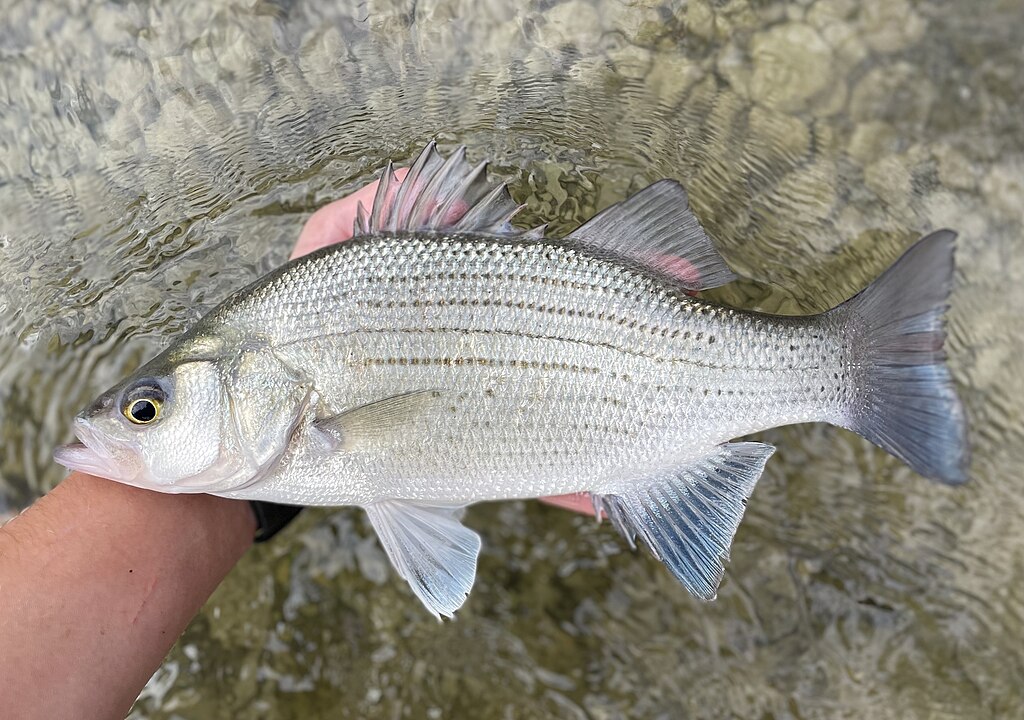
White Bass
Scientific Name: Morone chrysops
Also known as: Sand Bass, Silver Bass, White Perch, White Striper
General Description
The White Bass is a freshwater fish species that belongs to the Moronidae family, commonly found in rivers, lakes, and reservoirs across North America. Known for its distinct vertical black stripes that run across its silvery body, the White Bass is a popular target for sport anglers. It has an elongated, streamlined body with a slightly flattened head and sharp dorsal spines. White Bass are typically smaller than their relatives, the Striped Bass, but they still provide a challenging and exciting fight for anglers. They can grow up to 15 pounds, but most specimens are between 1-4 pounds.
White Bass are known for their aggressive feeding habits and will readily strike at a variety of bait types. They are commonly found in schools, especially during their spawning season. While they are not as large as other bass species, White Bass make up for their size with speed and agility, making them a fun catch. Their high-energy behavior and willingness to bite make them a favorite among anglers who enjoy fast-paced fishing.
Where to Find Them
White Bass are typically found in both large and small rivers, lakes, and reservoirs throughout the United States, with a preference for clear, cooler waters. They are most abundant in the Midwest and along the Eastern Seaboard, particularly in the Great Lakes and tributaries of the Mississippi River.
During the spring and early summer months, White Bass migrate from deep waters to shallow, warmer areas to spawn. During this period, they are particularly abundant in the shallows of larger lakes, especially near points, sandbars, and creek mouths. In rivers, they tend to gather in schools around riprap, bridge pilings, and the mouths of tributary streams. Outside of the spawning season, White Bass may disperse into deeper waters of lakes and reservoirs. They can also be found in warmer waters in the summer months when they gather in schools near drop-offs or submerged structures like rocks and logs.
Though they can be found in many parts of North America, White Bass are most commonly caught in the central U.S. and in states like Texas, Ohio, and Tennessee. They are also popular among anglers in the Great Lakes, where they can grow larger in the cooler waters.
Best Baits
Live Bait Options
- Minnows (shiners, fathead minnows)
- Worms (nightcrawlers, red wigglers)
- Crayfish
- Small shad
- Insects (grasshoppers, crickets)
Artificial Bait Options
- Jigs (especially white or silver-colored)
- Small crankbaits
- Soft plastics (small swimbaits, grubs)
- Spinners and spoons
- Topwater lures (during active feeding periods)
Best Fishing Methods
Fishing for White Bass can be both exciting and fast-paced, especially when they are feeding actively in schools. One of the most effective techniques for targeting White Bass is casting small jigs or spinners into areas where schools are known to congregate. These baits mimic the small baitfish that White Bass love to chase. Using light to medium tackle is ideal for catching these aggressive fish, as it allows anglers to cast longer distances and feel the subtle bites of the fish.
Trolling with small crankbaits or spoons is also a popular method for targeting White Bass in open water. Anglers can troll along drop-offs, submerged points, or deeper areas to locate schools of fish. During the spring spawn, bank fishing near shallow coves and spawning areas is often productive, as the White Bass move into these regions to reproduce.
When the fish are actively feeding, topwater lures such as poppers or walking baits can yield great results. These lures create a commotion on the surface, drawing the attention of White Bass that are chasing baitfish. For those targeting White Bass in rivers, fishing around submerged structures such as rocks, bridge pilings, or swift current areas is highly effective.
White Bass can be caught year-round, but they are most active during the spring and early summer, especially around spawning times. Anglers can often catch them at dawn or dusk when the fish are more likely to be feeding in shallow areas. When not actively spawning, White Bass may be found in deeper, cooler waters, particularly during the heat of the summer months.
Summary
Fishing for White Bass is a thrilling experience, as these energetic fish put up a strong fight despite their relatively small size. Their aggressive feeding behavior makes them highly susceptible to a variety of bait and lures, providing anglers with multiple options for successful catches. Whether casting small jigs along the shoreline, trolling with crankbaits in open waters, or fishing topwater lures during the feeding frenzy, targeting White Bass can be an exciting and productive pursuit.
White Bass are most abundant during the spring and early summer, particularly in shallow, warmer waters where they gather to spawn. Their preference for clear, cool waters in rivers and lakes across North America makes them an ideal species for anglers looking for a fast-paced fishing experience. While they can be found year-round, spring and summer are the best seasons to target White Bass, as they actively chase baitfish and school in large numbers.
For anglers seeking an exciting, action-packed fishing adventure, the White Bass is a perfect choice. Whether fishing from a boat or along the shore, anglers will find these fish plentiful in many areas of the U.S., providing ample opportunities for sport fishing enthusiasts to enjoy a rewarding catch.
Related
White Bass Run Secrets: Top Gear & Lures for Spring
Springtime creek fishing for white bass is one of the most exciting experiences an angler…



